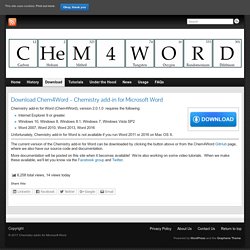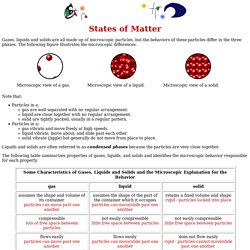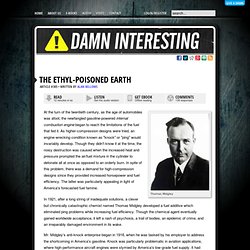

Download Chem4Word - Chemistry add-in for Microsoft Word. Chemistry add-in for Word (Chem4Word), version 2.0.1.0 requires the following: Internet Explorer 9 or greater.Windows 10, Windows 8, Windows 8.1, Windows 7, Windows Vista SP2Word 2007, Word 2010, Word 2013, Word 2016 Unfortunately, Chemistry add-in for Word is not available if you run Word 2011 or 2016 on Mac OS X.

Create Chemistry Equations and Diagrams in Word. Microsoft Word is a great tool for formatting text, but what if you want to insert a chemistry formula or diagram?

Thanks to a new free add-in for Word, you can now insert high-quality chemistry formulas and diagrams directly from the Ribbon in Word. Microsoft’s new Education Labs has recently released the new Chemistry Add-in for Word 2007 and 2010. This free download adds support for entering and editing chemistry symbols, diagrams, and formulas using the standard XML based Chemical Markup Language. You can convert any chemical name, such as benzene, or formula, such as H2O, into a chemical diagram, standard name, or formula. Chemistry Freeware. On this page I post reviews and links to freeware chemistry programs available for download at other sites around the internet.

All of the programs are ones that I have used, or currently use. None-the-less, I take no responsiblity for any problems you might experience as a result of installing any of these applications. Unless otherwise noted, the programs are for Windows systems. ACD/ChemSketch 12 Freeware. ACD continues to release updates to the outstanding Chemsketch freeware. MolView.Org is a web-based molecular viewing and modeling tool.
Discovery Studio Visualizer 4. ChemAxon produces a wide range of Java-based chemistry tools, and they offer free academic licenses (you must register with them). The Virtual Laboratory from the ChemCollective is a personal favorite. KnowItAll Academic Edition - In a continued commitment to academia, Bio-Rad is offering this completely FREE and fully functional software package to promote learning and research in the academic community. ChemCollective: HTML5 Virtual Lab. We are pleased to announce a new HTML5 based version of the virtual lab.

This beta release does not require the Java Plug-in and should run in most browsers. Please read the information below to help you get started. Caffeine. Liquid Nitrogen Experiments: The Balloon. Let's Pour Liquid Nitrogen on the Floor! DR. QUANTUM - DOUBLE SLIT EXPERIMENT. Emission Spectra. Just How Small Is an Atom? Whether we’re zooming in to the wavelength of a gamma ray or zooming out to the size of a galaxy, it can be difficult to wrap our heads around the big numbers we’re measuring—like nanometers (10-9meters) or gigameters (109).

Take a look at these efforts to represent big numbers. What are the strengths of each? How would you represent a large number (like a gigameter)? Cary Huang: The Scale of the Universe 2 NOVA: A Sense of Scale: String Theory Chris Jordan pictures some shocking stats More than 2,400 years ago, the Greek philosopher Democritus began thinking about how many times matter could be divided.
He proposed that there were, in fact, tiny, indivisible pieces of matter that he called “atomos,” meaning “not to be cut.” A Look Inside the Atom. Molecules Help Page. Free Chemistry Animations- Learnerstv. The ChemCollective: Review of Buffers - How Buffers Work. The 7DC Particle Model of Matter. States of Matter. States of Matter Gases, liquids and solids are all made up of microscopic particles, but the behaviors of these particles differ in the three phases.

The following figure illustrates the microscopic differences. Note that: Particles in a: gas are well separated with no regular arrangement. Liquid are close together with no regular arrangement. The following table summarizes properties of gases, liquids, and solids and identifies the microscopic behavior responsible for each property. The Ethyl-Poisoned Earth. Thomas Midgley At the turn of the twentieth century, as the age of automobiles was afoot, the newfangled gasoline-powered internal combustion engine began to reach the limitations of the fuel that fed it.

As higher-compression designs were tried, an engine-wrecking condition known as "knock" or "ping" would invariably develop. Though they didn't know it at the time, the noisy destruction was caused when the increased heat and pressure prompted the air/fuel mixture in the cylinder to detonate all at once as opposed to an orderly burn. In spite of this problem, there was a demand for high-compression designs since they provided increased horsepower and fuel efficiency. The latter was particularly appealing in light of America's forecasted fuel famine. In 1921, after a long string of inadequate solutions, a clever but chronically catastrophic chemist named Thomas Midgley developed a fuel additive which eliminated ping problems while increasing fuel efficiency. A Short History of Nearly Everything - Bill Bryson.
C025 Saturation and crystallisation. Osmosis.mp4. How Water Dissolves Salt. Dissociation of salt. Atomic d orbitals. Atomic orbitals - electron configuration of Scandium (Z=21) Giant Koosh Ball in Liquid Nitrogen! Liquid Nitrogen Experiments: The Balloon. Dr Quantum - quantum physics simplified! Reactions of sodium and Potassium with Water. Charles Law @ Carleton University. Alkali metals in water, accurate!